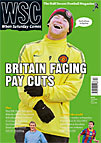 With players going down easier, Matt Nation believes football is fast becoming a contactless sport
With players going down easier, Matt Nation believes football is fast becoming a contactless sport
Watch an Over-55s game on my local pitch and you’ll rarely see a foul. The players may regale whoever will listen with stories of how a match wasn’t a match unless they’d broken their jaw at least once and then barged the opposing goalkeeper so hard that the game had to be stopped so that people could go and look for him, but they’re remarkably mild-mannered on the pitch. They have to be. Tackling is frowned upon or, if the referee is getting on a bit himself, banned outright.
This is completely understandable. You only need to recall a grandparent stumbling over an uneven paving stone to know how ill-equipped ageing bones are to deal with taking a tumble. However, even in the league that I play in, where, due to the lack of officials, everybody is their own referee and bad behaviour is punished not by cards, but by being harangued after the game, contact-free football appears to be taking over. Take, for instance, the not uncommon scene of a forward shielding the ball with his back to goal. The defender is standing there, all scarecrow arms and telephone-stalker breath, the forward is nudging and wriggling and stroking the ball with his studs for absolutely no reason at all. After five seconds, the forward will more often than not just crumple to the ground, brought down by nothing more than a bit of light frottage and an inability to know what to do next.
It’s no different with shoulder-to-shoulder contact: lean on somebody with any more force than you would when flirting with a work colleague at an office do and they’ll be reeling away like something you used to see on the dancefloor at a Wigan Casino all-nighter. And you can forget block tackles, the ones where the weight distribution is just textbook-perfect enough to have your opponent trip over the ball and fly through the air with the ignominy of Charlie Brown attempting to kick a field goal. Do one of those on a grass pitch and you’ll get stern looks. Do one on a cinder pitch and people will be prodding you in the chest and asking you whether you know that your victim has got a wife and two kids to feed.
Michel Platini and other enemies of the tackle will no doubt regard this development with enthusiasm. And one can sympathise up to a point; after all, despite what certain papers say, nobody really “loves a tackle”. A tackle is a necessary evil, about as interesting as doing, or watching somebody doing, the ironing. However, this so-called “sanitisation” has also given rise to one of the banes of the modern game: shepherding the ball out of play.
Those of a certain vintage will recall Peter Beardsley in his prime. Shoulders hunched, hair bouncing like a cocker spaniel’s ears, mouth slightly ajar, he’d often chase long balls “down the channel” together with Pallister, Bruce or one of the other Rubenesque defenders of the time. Just as the cause was beginning to look lost, Beardsley would pounce: with a deft flick of the ankle, he’d lodge the ball between his foot and the defender’s. Off-balance, his adversary would be left floundering like a fatty falling off a trampoline on YouTube, while Beardsley would shuffle off for a carefree one-on-one with the keeper.
Today, Peter Beardsley would be lucky to stay on the pitch for longer than two tackles. Any ball rolling towards the byline nowadays is accompanied by a defender zigging and zagging, proffering the forward his hind quarters in a manner normally seen only among female housecats in springtime. If he tried this in any other situation, he’d be penalised immediately (or lampooned; think Emile Heskey doing the same thing 50 yards further up the pitch) but en route to one of his own corner flags, it’s considered perfectly acceptable behaviour.
Should the forward attempt to get a foot in, then the defender will, with flagrant disregard of Hansen’s Law that a good defender is one who stays on his feet, chuck himself onto an unsuspecting photographer or fall to his knees as unexpectedly as Willy Brandt in Warsaw. Nine times out of ten, the referee will blow for a foul. Even if he doesn’t and the ball rolls shamefacedly out of play, the defender will wheel away, shoulders back, chest out and with applause ringing in his ears, as though he’s just rescued a drowning child rather than simply failed to touch a football.
It’s the professional two-footers and chest-studders who are to blame for this creeping bowdlerisation of the game. If you’re a referee, particularly at a lower level, where the rewards often extend to nothing more than petrol money and a bowl of soup after the game, nobody will blame you for taking the route of least resistance, for preventing rather than curing, for penalising moderate physical contact and thereby strangling the leg-breaking stuff at birth.
And as lower-level referees come up through the ranks to the top, there will come a time when everybody has to play or watch games dominated by ball-shepherders and grown men falling over on purpose more often than Norman Wisdom could ever have dreamt of. And what are the pancake-flippers going to do then? Time to brush up on your soft skills, Nigel.
From WSC 286 December 2010